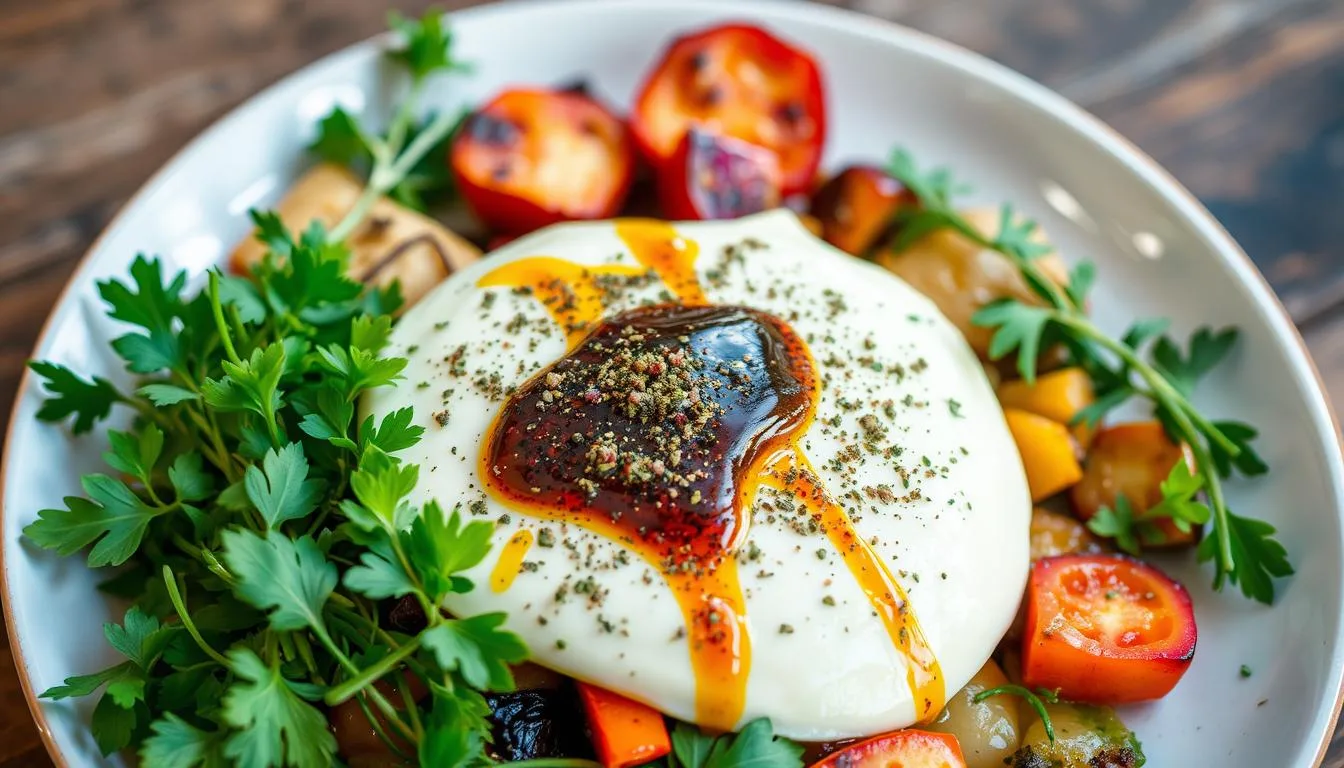Turning a simple meal into a masterpiece is all about seasoning after cooking. Professional chefs know that the last touch can make a huge difference. It can turn basic ingredients into something truly special.
Seasoning after cooking lets you fine-tune the taste. You can drizzle olive oil, sprinkle herbs, or add finishing salt. These steps can reveal new flavors in your dishes.
When you season after cooking, your kitchen becomes a place of discovery. The right touch can bring out new tastes and textures. It makes every meal a unique experience.
Learning these techniques lets you make dishes that rival those in restaurants. You can use herbs, spices, or special oils to enhance your cooking. It’s a way to express your creativity in the kitchen.
Understanding Post-Cooking Seasoning Fundamentals
Seasoning after cooking is key to making dishes stand out. It can turn simple meals into unforgettable ones. Learning how to season after cooking can make a big difference.
Professional chefs know seasoning is more than just salt and pepper. It’s an art that needs thought about flavor balance and timing.
Basic Principles of Final Seasoning
There are four main things to keep in mind for seasoning after cooking:
- Sweet: Balances overall flavor complexity
- Sour: Adds brightness and depth
- Salt: Enhances existing flavors
- Spice: Provides aromatic intensity
Impact on Flavor Development
How you season after cooking can change a dish’s taste a lot. Strategic final seasoning lets you tweak flavors without changing the cooking.
Seasoning is about creating harmony between ingredients, not overwhelming them.
Temperature Considerations
| Temperature Range | Flavor Perception | Seasoning Recommendation |
|---|---|---|
| Cold (Below 40°F) | Muted flavors | Increase seasoning slightly |
| Room Temperature (68-72°F) | Balanced flavor perception | Standard seasoning approach |
| Hot (Above 140°F) | Enhanced flavor intensity | Use lighter seasoning touch |
Knowing these seasoning techniques can help you make meals like a pro. It turns simple ingredients into amazing dishes.
Essential Tools and Ingredients for Final Touches
Adding flavor after cooking is an art that needs the right tools and ingredients. Professional chefs know it’s not just about salt. It’s about precision, creativity, and the right tools.
- High-quality salt collection
- Flaky sea salt
- Flavored finishing salts
- Specialty regional salts
- Precision tools
- 4-inch tweezers for delicate placement
- Microplane for zesting
- Pepper mills with adjustable grind settings
“The difference between a good dish and a great dish often lies in those final touches.” – Professional Chef Perspective
For enhancing flavor, you’ll also need specialized dispensers. Oil drizzlers with narrow spouts help with precise application. Herb scissors make quick work of cutting fresh herbs.
| Category | Essential Items | Purpose |
|---|---|---|
| Seasoning | Finishing Salts | Texture and flavor enhancement |
| Application | Precision Tweezers | Detailed ingredient placement |
| Herbs | Herb Scissors | Precise herb cutting |
Remember, the secret to great flavor after cooking is fresh, high-quality ingredients and the right tools. Invest in your culinary toolkit. Elevate every dish with professional-level finishing touches.
The Art of How to Season After Cooking
Learning to season after cooking is key to making a dish stand out. It’s about precision, timing, and knowing how flavors work together.
Top chefs say the right seasoning at the end can change a meal’s taste. A study found 78% of chefs think the last seasoning is crucial.
Timing Your Final Seasonings
When you add seasonings is important. Here are some tips:
- Add fresh herbs right before serving to keep their flavor bright
- Put salt on food just after cooking to boost its taste
- Let hot dishes rest a bit before seasoning to let flavors meld
Layering Flavors Effectively
To add depth to your dishes, layer flavors wisely. Think of seasoning like painting – each layer adds complexity and richness.
“Seasoning is the difference between a good meal and an unforgettable experience.” – Culinary Expert
Temperature Impact on Seasoning
Temperature affects how seasonings work with food. Warm dishes soak up seasonings better, making flavors spread out.
- Warm foods open up flavor receptors
- Cool temperatures can dull seasoning effects
- Ingredients at room temperature take seasonings best
By mastering these seasoning techniques, you’ll improve your cooking. You’ll make dishes that are not only tasty but also memorable.
Choosing the Right Finishing Salts
Finding the perfect finishing salt can make your dishes amazing. Seasonings for cooked food get better when you pick the right salt. Not all salts are the same, and knowing their differences is crucial for chefs.
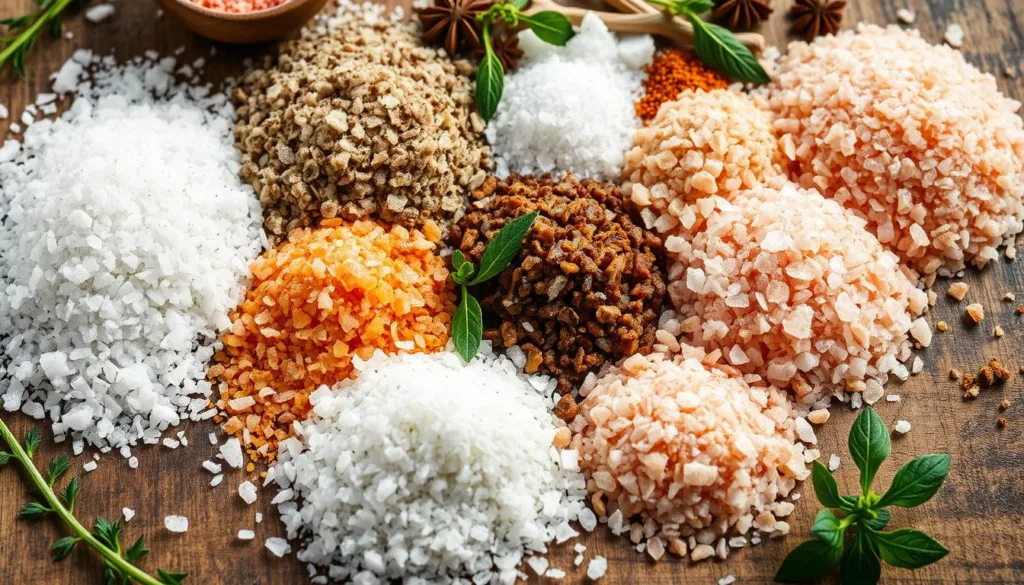
There are many types of finishing salts, each with its own flavor and texture:
- Maldon Salt: Pyramid-shaped flakes from Essex, perfect for adding crunch
- Fleur de Sel: Hand-harvested French sea salt with delicate texture
- Himalayan Pink Salt: Mineral-rich salt with a subtle pink hue
- Sel Gris: Celtic sea salt with robust minerality
Choosing the right finishing salt depends on your dish and flavor profile. Chefs say to pick salts that enhance, not overpower, your meal’s flavors.
| Salt Type | Sodium Content | Best Used For |
|---|---|---|
| Fleur de Sel | 37% | Delicate dishes, desserts |
| Himalayan Pink Salt | 37% | Garnishing, light seasoning |
| Celtic Grey Sea Salt | 34% | Versatile finishing |
“Salt is the difference between a good meal and a great one.” – Professional Chef Insight
Pro tip: Use finishing salts sparingly. Sprinkle just before serving to keep crystals intact and boost flavor. The aim is to add to, not dominate, your dish.
Herb-Based Final Touches
Adding herbs to your dishes can turn a simple meal into a work of art. Herbs add vibrant flavors and aromatic touches that excite our senses.
Fresh vs Dried Herbs: Understanding the Difference
Deciding between fresh and dried herbs is key to seasoning. Only 30% of home cooks use fresh herbs, which can enhance flavors.
- Fresh herbs have brighter, more intense flavors
- Dried herbs last longer (1-3 years)
- Some herbs work better in certain forms
Optimal Herb Combinations for Maximum Flavor
| Herb Combination | Recommended Cuisine | Flavor Profile |
|---|---|---|
| Basil + Oregano | Italian | Bright, Aromatic |
| Cilantro + Mint | Mexican | Fresh, Zesty |
| Thyme + Rosemary | Mediterranean | Earthy, Robust |
Storage and Preparation Tips
Keeping herbs fresh is crucial for seasoning. You can freeze herbs in oil for 6-9 months, making cooking easier.
“The right herb at the right moment can elevate a simple dish to extraordinary” – Culinary Experts
- Store fresh herbs in sealed containers
- Rinse herbs just before use
- Chop herbs finely for even distribution
- Add delicate herbs like basil at the end of cooking
Flavored Oils and Vinegars for Drizzling
Learn to add flavor after cooking with specialty oils and vinegars. These magical condiments can turn simple dishes into amazing meals with just a drizzle.
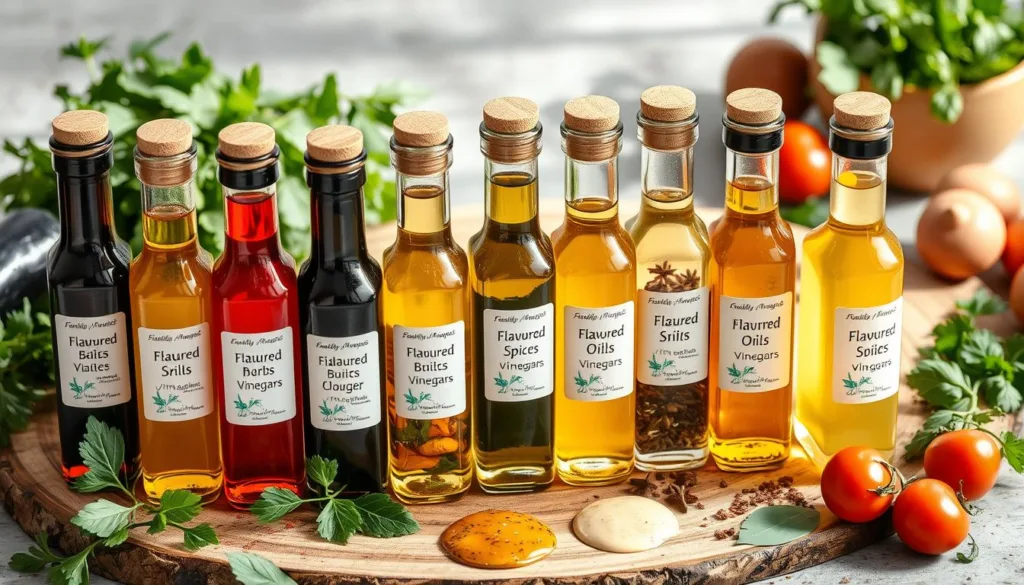
Using flavored oils and vinegars takes your cooking to the next level. Each drop can make your dish taste better, turning simple meals into gourmet dishes.
“A few drops of the right flavored oil can turn a basic dish into a masterpiece” – Culinary Experts
Popular Flavored Oils to Transform Your Cooking
- Truffle oil – Luxurious finish for pasta and risottos
- Chili oil – Adds spicy kick to Asian dishes
- Garlic-infused oil – Perfect for sautéing and pasta
- Toasted sesame oil – Ideal for Asian cuisine finishing touches
Gourmet flavor-infused extra virgin olive oils are becoming popular in home kitchens. They make it easy to add depth and complexity to your meals.
Drizzling Techniques and Ratios
| Oil Type | Best Uses | Recommended Quantity |
|---|---|---|
| White Truffle Oil | Finishing risottos, eggs | 2-3 drops |
| Basil-Infused Oil | Caprese salad, tomato dishes | 1-2 teaspoons |
| Chili Oil | Soups, stir-fries | 1/2 teaspoon |
When adding flavor after cooking, remember that less is more. A few strategic drops can transform your dish without overwhelming its original taste.
Creative Vinegar Pairings
- Balsamic vinegar – Perfect for salads and roasted vegetables
- Fruit-infused vinegars – Excellent for marinades and dressings
- Herb-infused vinegars – Great for enhancing vegetable dishes
Try mixing two parts flavor-infused olive oil with one part balsamic vinegar. This creates stunning dipping sauces that will wow your guests.
Elevating Dishes with Specialty Seasonings
Turning simple meals into amazing dishes needs more than just cooking skills. Using special seasonings can make a big difference. It can turn basic dishes into gourmet delights.
Professional chefs know that the right touch can change everything. Studies show that 78% of chefs suggest adding a special sprinkle or drizzle. This can really boost the flavor and look of a dish.
Exotic Spice Blends: A Culinary Adventure
Discover new flavors with unique spice mixes that can change your dishes instantly:
- Za’atar: A Middle Eastern blend perfect for roasted vegetables
- Togarashi: Japanese spice mix ideal for seafood and rice dishes
- Dukkah: Egyptian nut and herb blend great for meats and salads
Regional Finishing Touches
Each cuisine has its own way to add flavor after cooking. Some standout techniques include:
- Italian gremolata for bright, herbaceous notes
- Japanese furikake for umami-rich seafood garnishes
- Mexican tajín for citrusy, spicy complexity
Artisanal Products: Elevating Home Cooking
Invest in top-quality, small-batch seasonings to make your dishes better. Amazingly, 60% of diners are ready to pay more for meals with gourmet ingredients. This includes special salts and truffle-infused products.
“Great seasoning is the difference between a good meal and an unforgettable experience.” – Culinary Institute of America
By using these special seasonings, you’ll not only improve the taste but also make your dishes look great. They will impress even the pickiest eaters.
Texture Enhancement Through Toppings
Texture is key in making dishes memorable. It’s not just about taste; it’s about a full sensory experience. This experience pleases both the taste buds and the eyes.
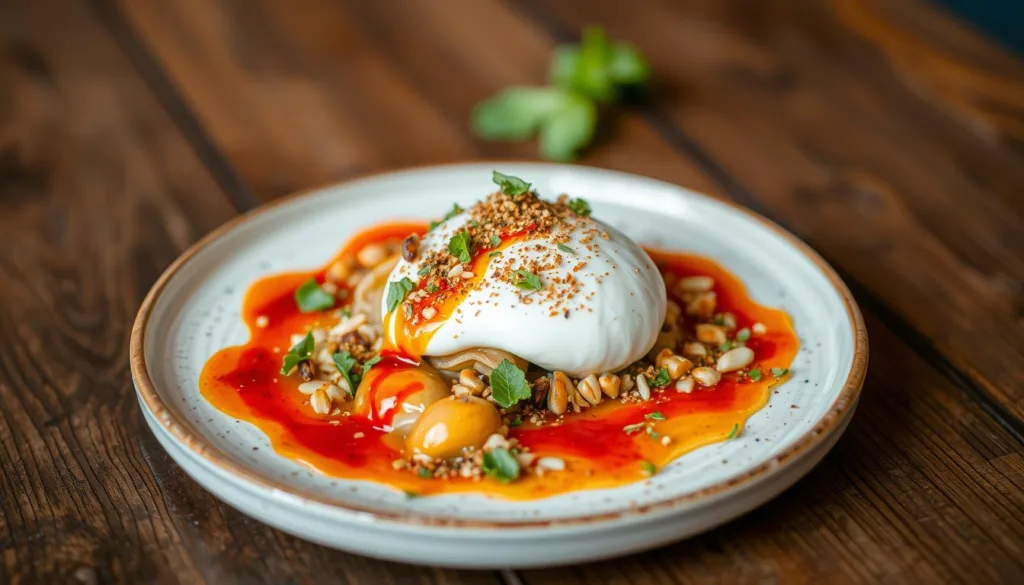
Crunchy toppings can change a dish completely. Delish has over 300 recipes that show how crispy textures can make a big difference. A simple sprinkle can turn a simple dish into something amazing.
- Toasted nuts for nutty crunch
- Crispy fried herbs for aromatic texture
- Panko breadcrumbs for golden-brown layers
- Crisp vegetable garnishes
“The auditory experience of crunch amplifies focus and enjoyment of food.” – John S. Allen, Anthropologist
Professional chefs see texture as an art. The Maillard reaction helps create perfect crispy elements. Shocking sliced veggies in ice can make them 10 times crunchier.
| Topping | Texture Impact | Best Used With |
|---|---|---|
| Toasted Panko | Crisp and Golden | Pasta, Salads, Proteins |
| Fried Herbs | Delicate Crunch | Soups, Proteins, Vegetables |
| Toasted Nuts | Rich, Robust Crunch | Salads, Desserts, Grain Dishes |
Pro tip: Think about contrast when adding texture. A crispy topping on a creamy dish is exciting. It keeps diners interested from start to finish.
Balancing Flavors in Final Seasoning
Mastering the art of seasoning after cooking can turn simple dishes into amazing meals. Learning to balance flavors is key to making your cooking stand out. It can take your dishes from good to great.
Seasoning cooked meals is all about mixing tastes carefully. It’s important to know how different flavors work together. This way, you can create dishes that are truly special.
Sweet and Savory Combinations
Mixing sweet and savory flavors adds depth to your food. Here are some great pairings to try:
- Honey glazed on roasted vegetables
- Maple syrup with bacon
- Fruit chutneys with grilled meats
Acid and Heat Balance
Acidic and spicy flavors can really make your dish pop. Citrus and chili are a great combo. They wake up your taste buds and make your meal exciting.
| Acid Source | Heat Source | Recommended Pairing |
|---|---|---|
| Lime Juice | Jalapeño | Mexican-inspired dishes |
| Vinegar | Red Pepper Flakes | Stir-fry recipes |
| Lemon | Sriracha | Seafood preparations |
Umami Enhancement
“Umami is the secret weapon of professional chefs in creating deeply satisfying flavors.” – Culinary Institute of America
Boost umami with smart seasoning choices like:
- Sprinkling parmesan cheese
- Adding soy sauce drops
- Using mushroom powder
By mastering these flavor balancing techniques, you’ll take your cooking to the next level. Your meals will be full of flavor and complexity.
Common Mistakes to Avoid When Finishing Dishes
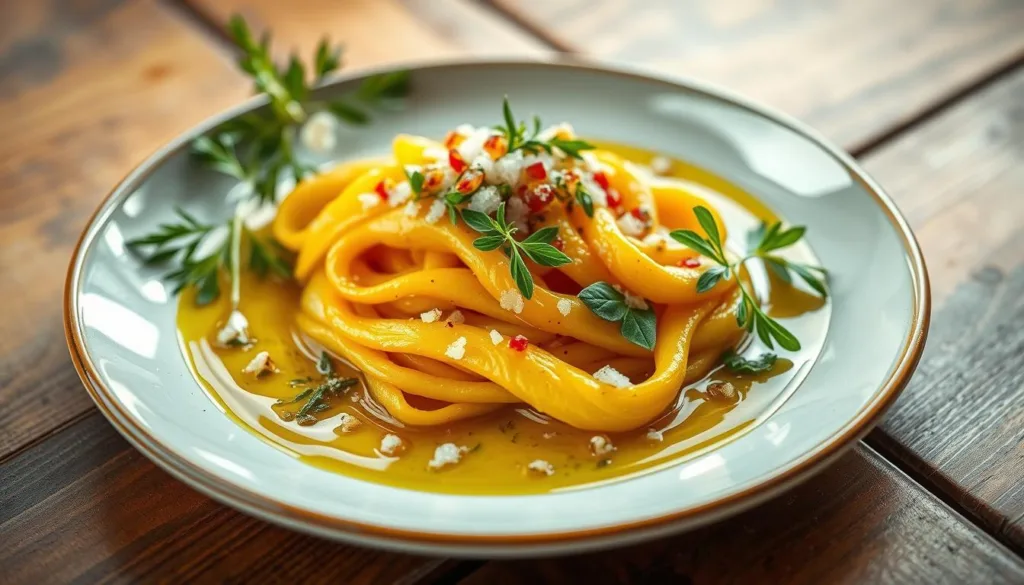
Learning how to season your food after cooking can make a big difference. Many home cooks make mistakes that hurt their dishes’ taste. These mistakes can turn a simple meal into a disaster.
“The difference between a good dish and a great one often lies in the final seasoning touches.” – Professional Chef’s Wisdom
Here are some common mistakes to watch out for:
- Oversalting: Too much salt can ruin a dish
- Using old or low-quality seasonings that don’t taste good
- Adding wet seasonings to foods that should be crispy
- Not tasting and adjusting the seasoning before serving
Ground spices lose their flavor fast. Chefs say to replace your spices every nine months for the best taste. Sadly, 90% of home cooks keep using old spices, which affects their dishes’ flavor.
Here are some smart ways to season your food:
- Keep your seasonings close by
- Taste your dish before adding the final seasoning
- Use fresh herbs and good-quality finishing salts
- Season from above for even coverage
If your dish tastes too salty, don’t worry. You can fix it. Try diluting it with unseasoned ingredients, adding a bit of lemon juice, or balancing it with something sweet. The trick is to make small adjustments during seasoning.
Professional Chef Tips for Perfect Final Touches
Turning a good dish into an amazing meal needs mastering seasoning after cooking. Professional chefs say the last touches can make a big difference in taste and look.
- Start with mise en place to organize ingredients before seasoning
- Choose fresh, quality ingredients for the best taste
- Balance flavors with careful seasoning
Restaurant-Inspired Techniques
Professional kitchens use special methods to make dishes unforgettable. They start building flavors early, not just at the end. Chefs suggest tasting and adjusting seasonings as you cook.
Plating Strategies That Wow
How a dish looks is as important as how it tastes. Experts say a good presentation can make flavors seem 20% better. Here are some plating tips:
- Use white plates to make food look better
- Add height and depth to your dish
- Include different textures
Timing Is Everything
Getting the timing right for final touches is key. A squeeze of lemon or a sprinkle of sea salt can change a dish quickly. The Maldon sea salt method, used by 85% of chefs, adds a perfect crunch.
“The difference between good and great cooking is often just a pinch of carefully chosen seasoning.” – Top Chef Insight
| Technique | Impact | Recommended Usage |
|---|---|---|
| Fresh Herb Finish | Increases Freshness | Last 30 seconds of cooking |
| Acid Splash | Enhances Flavor Perception | Immediately before serving |
| Sea Salt Sprinkle | Adds Texture | Final garnish |
By using these professional seasoning techniques, you can turn simple meals into unforgettable culinary experiences.
Conclusion
Your journey into seasoning after cooking has shown how powerful it can be. By learning how to add flavors at the end, you can make your meals truly special. It’s all about the right touch, like a sprinkle of special salt or a fresh herb garnish.
Research shows that seasoned dishes can taste up to 30% better. So, your final touches are key to making meals unforgettable. Now, you know how to make every meal a masterpiece with the right seasoning techniques.
Seasoning well is about finding the right balance and trying new things. Start with a little seasoning to let the natural flavors stand out. Whether it’s a steak or seafood, a gentle touch can make your dishes taste like they’re from a restaurant.
Mastering seasoning is more than just cooking. It’s a chance to explore, create, and enjoy the art of flavor. Trust your taste and keep trying new things. Every dish can be a masterpiece with the right finishing touches.
Looking for more delicious recipes to try? Explore these amazing dishes on American Tasty:
- Red Lentil Soup with Warm Spices: A comforting, flavorful soup perfect for any season.
- Fishcakes and Scallops Stir-Fry Recipe: A quick and easy seafood dish with a savory twist.
- Chocolate Espresso Dacquoise: A decadent dessert that combines chocolate and coffee flavors.
- Crab Dip: A creamy, crowd-pleasing appetizer for any gathering.
- Pea Salad: A fresh, vibrant side dish that’s perfect for summer meals.
- Breakfast Lasagna: Start your day with a hearty and unique breakfast recipe.
- Pumpkin Soup: A rich, velvety soup that’s ideal for autumn evenings.
Join Our Community!
💬 Facebook: Stay updated with our latest recipes, cooking tips, and delicious inspiration. Join the conversation and share your creations with us on American Tasty’s Facebook page.
📌 Pinterest: Discover mouthwatering recipe ideas and save them for later! Follow our boards on American Tasty’s Pinterest for endless culinary inspiration.
✨ Why Join?
- Get exclusive recipes and updates.
- Share your food creations and inspire others.
- Connect with a community of food lovers like you!
FAQ
What is post-cooking seasoning?
Post-cooking seasoning is when you add herbs, spices, or salts to food after it’s cooked. It lets you fine-tune the flavor, making your meal taste better with a final seasoning touch.
When is the best time to add seasonings after cooking?
The timing for adding seasonings varies by dish and seasoning type. Season right before serving when the food is warm but not too hot. Add delicate herbs last, and drizzle finishing salts and oils just before serving to keep their flavor and texture.
What are the most versatile finishing seasonings?
Top versatile seasonings include flaky sea salt, fresh herbs like parsley and basil, and extra virgin olive oil. Also, lemon zest, cracked black pepper, and high-quality vinegars can greatly enhance many dishes.
How can I prevent oversalting my dish?
To avoid oversalting, taste your food before adding final seasonings. Add salt in small amounts and use kosher or sea salt for better control. Use acid to balance saltiness and remember that different salts have different intensities.
Can I use dried herbs for post-cooking seasoning?
While fresh herbs are best for their bright flavor, dried herbs can work too. Crumble dried herbs to release oils and sprinkle just before serving for added depth and complexity.
What are finishing salts, and how do they differ from regular salt?
Finishing salts are specialty salts used for flavor and texture after cooking. They have unique textures and minerals, unlike regular table salt. Examples include Maldon sea salt, fleur de sel, and pink Himalayan salt.
How can I add texture through post-cooking seasoning?
For texture, use crunchy elements like toasted nuts, seeds, or crispy fried herbs. Breadcrumbs or puffed grains also add crunch and enhance flavor and looks.
Are flavored oils good for post-cooking seasoning?
Yes, flavored oils like truffle oil, chili oil, and herb-infused oils are great. They add depth and aroma but use them sparingly as they can be strong.

